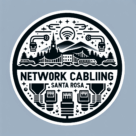What Are the 4 Types of Network Cables? | Complete Guide for Beginners
Whether you’re setting up a home internet connection or designing a professional network, understanding the different types of network cables is essential. Each cable type has a specific role in how data travels from one device to another — and choosing the right one can make all the difference in your network’s speed, reliability, and performance.
Let’s break down the four main types of network cables, their uses, and which one is best for your setup. Our team of structured cabling experts in Santa Rosa installs high-quality network cables that ensure fast and stable connectivity for homes and businesses.
1. Twisted Pair Cables
Twisted pair cables are the most common type of networking cable used today. They consist of pairs of copper wires twisted together to reduce electromagnetic interference (EMI).
There are two main kinds:
- Unshielded Twisted Pair (UTP): Common in home and office networks, including Ethernet connections like CAT5e, CAT6, and CAT6a.
- Shielded Twisted Pair (STP): Includes an extra layer of shielding to protect against interference, ideal for industrial or high-electrical environments.
Pros:
- Affordable and easy to install
- Widely available and versatile
- Supports high-speed Ethernet (up to 10 Gbps with CAT6a)
Cons:
- Shorter range compared to fiber
- Can be affected by nearby electrical interference
Twisted pair cables are typically used for local area networks (LANs), making them the standard choice for most homes and offices.
2. Coaxial Cables
Coaxial cables (or coax cables) have been around for decades and are still used in many applications today. They feature a copper conductor surrounded by insulation, shielding, and an outer protective layer.
These cables were once the backbone of older Ethernet networks and are still commonly used for:
- Cable television (TV) connections
- Internet service from cable providers
- CCTV and surveillance systems
Pros:
- Strong resistance to signal interference
- Supports long-distance transmission
- Durable and well-shielded
Cons:
- Bulkier and less flexible than twisted pair
- Slower data transfer rates compared to modern Ethernet cables
While coaxial cables aren’t the top choice for new network installations, they remain valuable for specific applications like security camera systems and broadband internet.
3. Fiber Optic Cables
Fiber optic cables are the fastest and most advanced type of network cable available today. Instead of using copper wires, they transmit data as pulses of light through strands of glass or plastic.
There are two main types:
- Single-mode fiber (SMF): Designed for long-distance communication — ideal for data centers, ISP backbones, and campus networks.
- Multi-mode fiber (MMF): Used for shorter distances, such as within office buildings or server rooms.
Pros:
- Extremely high speeds (up to 100 Gbps or more)
- Immune to electromagnetic interference
- Can transmit data over long distances without loss
Cons:
- Higher cost for materials and installation
- More delicate and requires specialized tools to terminate
Fiber optic cables are perfect for businesses and facilities that need top-speed data transmission and future-proof infrastructure. When using Ethernet cables, length can affect performance — find out how long a LAN cable can be before signal loss becomes an issue.
4. USB Cables
While not always thought of as traditional network cables, USB (Universal Serial Bus) cables can also be used for data communication and device networking. They’re often used to connect computers to peripherals or to share internet connections via tethering.
Common use cases include:
- Connecting computers to printers, scanners, and external drives
- Network bridging between computers
- Internet tethering from mobile devices
Pros:
- Plug-and-play simplicity
- Widely compatible with modern devices
- Supports both data transfer and power delivery
Cons:
- Limited distance (usually under 16 feet without a repeater)
- Not suitable for large-scale networks
USB cables are best for personal or small-scale setups where convenience matters more than speed or distance.
Choosing the Right Network Cable
Selecting the right cable depends on your needs:
- For home networks and offices, CAT6 Ethernet cables are reliable and affordable.
- For high-speed or long-distance applications, fiber optic cables are the top choice.
- For TV, CCTV, or broadband connections, coaxial cables are still widely used.
- For simple device connections, USB cables get the job done.
Understanding these differences helps you build a faster, more efficient, and future-ready network — whether it’s for your home, office, or business.
Upgrade Your Network with the Right Cabling Solution
If you’re planning a network upgrade or installation, choosing the correct cable type is only part of the process. Proper installation, termination, and testing are equally important for reliable performance. Understanding the types of cables helps highlight why network cabling is essential for efficient data transmission and connectivity.
Professional installers can help design and set up your network based on your space, budget, and performance needs — ensuring every connection is secure and optimized for speed.
Contact your local network cabling experts today to find the best solution for your home or business.
